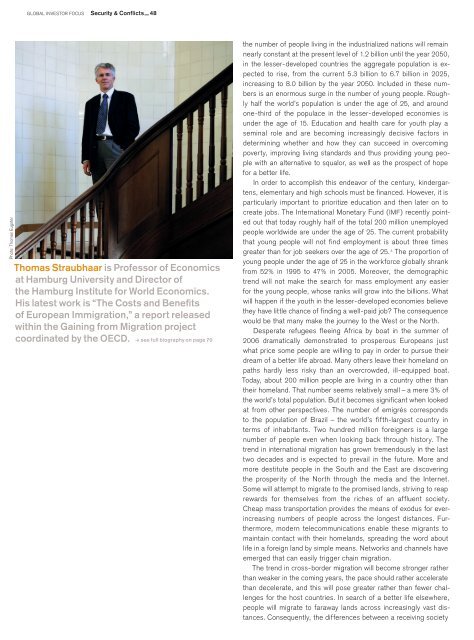Security & Conflicts
Global Investor Focus, 02/2006 Credit Suisse
Global Investor Focus, 02/2006
Credit Suisse
Create successful ePaper yourself
Turn your PDF publications into a flip-book with our unique Google optimized e-Paper software.
GLOBAL INVESTOR FOCUS <strong>Security</strong> & <strong>Conflicts</strong> — 48<br />
Photo: Thomas Eugster<br />
Thomas Straubhaar is Professor of Economics<br />
at Hamburg University and Director of<br />
the Hamburg Institute for World Economics.<br />
His latest work is “The Costs and Benefits<br />
of European Immigration,” a report released<br />
within the Gaining from Migration project<br />
coordinated by the OECD. see full biography on page 70<br />
the number of people living in the industrialized nations will remain<br />
nearly constant at the present level of 1.2 billion until the year 2050,<br />
in the lesser-developed countries the aggregate population is expected<br />
to rise, from the current 5.3 billion to 6.7 billion in 2025,<br />
increasing to 8.0 billion by the year 2050. Included in these numbers<br />
is an enormous surge in the number of young people. Roughly<br />
half the world’s population is under the age of 25, and around<br />
one-third of the populace in the lesser-developed economies is<br />
under the age of 15. Education and health care for youth play a<br />
seminal role and are becoming increasingly decisive factors in<br />
determining whether and how they can succeed in overcoming<br />
poverty, improving living standards and thus providing young people<br />
with an alternative to squalor, as well as the prospect of hope<br />
for a better life.<br />
In order to accomplish this endeavor of the century, kindergartens,<br />
elementary and high schools must be financed. However, it is<br />
particularly important to prioritize education and then later on to<br />
create jobs. The International Monetary Fund (IMF) recently pointed<br />
out that today roughly half of the total 200 million unemployed<br />
people worldwide are under the age of 25. The current probability<br />
that young people will not find employment is about three times<br />
greater than for job seekers over the age of 25. 3 The proportion of<br />
young people under the age of 25 in the workforce globally shrank<br />
from 52% in 1995 to 47% in 2005. Moreover, the demographic<br />
trend will not make the search for mass employment any easier<br />
for the young people, whose ranks will grow into the billions. What<br />
will happen if the youth in the lesser-developed economies believe<br />
they have little chance of finding a well-paid job? The consequence<br />
would be that many make the journey to the West or the North.<br />
Desperate refugees fleeing Africa by boat in the summer of<br />
2006 dramatically demonstrated to prosperous Europeans just<br />
what price some people are willing to pay in order to pursue their<br />
dream of a better life abroad. Many others leave their homeland on<br />
paths hardly less risky than an overcrowded, ill-equipped boat.<br />
Today, about 200 million people are living in a country other than<br />
their homeland. That number seems relatively small – a mere 3% of<br />
the world’s total population. But it becomes significant when looked<br />
at from other perspectives. The number of emigrés corresponds<br />
to the population of Brazil – the world’s fifth-largest country in<br />
terms of inhabitants. Two hundred million foreigners is a large<br />
number of people even when looking back through history. The<br />
trend in international migration has grown tremendously in the last<br />
two decades and is expected to prevail in the future. More and<br />
more destitute people in the South and the East are discovering<br />
the prosperity of the North through the media and the Internet.<br />
Some will attempt to migrate to the promised lands, striving to reap<br />
rewards for themselves from the riches of an affluent society.<br />
Cheap mass transportation provides the means of exodus for everincreasing<br />
numbers of people across the longest distances. Furthermore,<br />
modern telecommunications enable these migrants to<br />
maintain contact with their homelands, spreading the word about<br />
life in a foreign land by simple means. Networks and channels have<br />
emerged that can easily trigger chain migration.<br />
The trend in cross-border migration will become stronger rather<br />
than weaker in the coming years, the pace should rather accelerate<br />
than decelerate, and this will pose greater rather than fewer challenges<br />
for the host countries. In search of a better life elsewhere,<br />
people will migrate to faraway lands across increasingly vast distances.<br />
Consequently, the differences between a receiving society

















